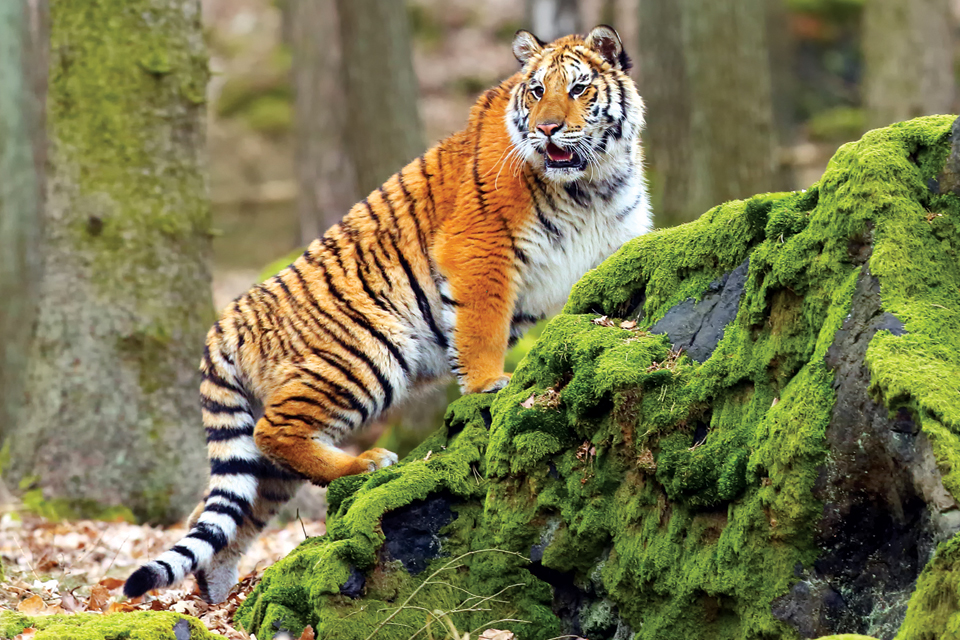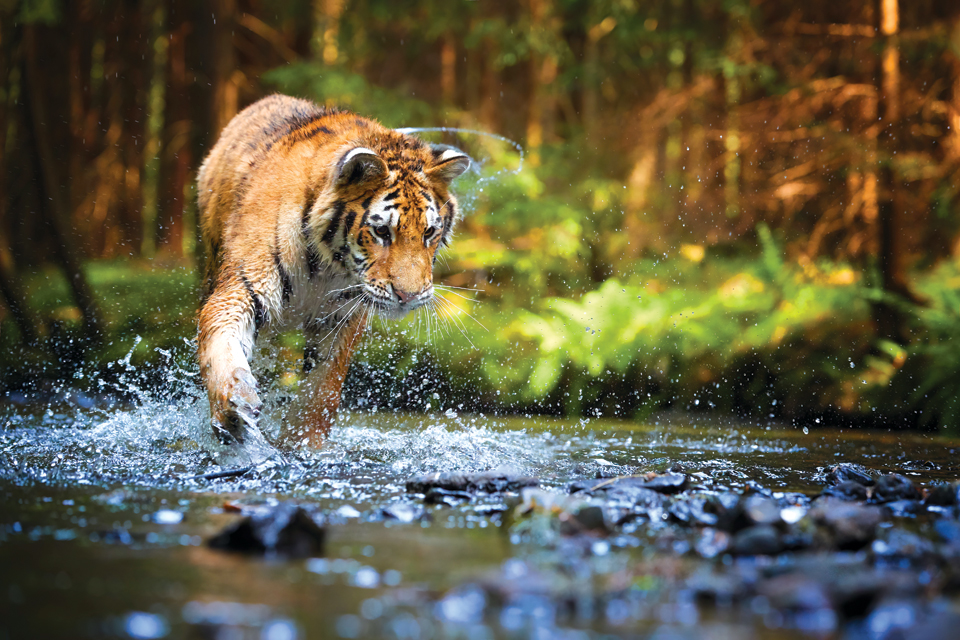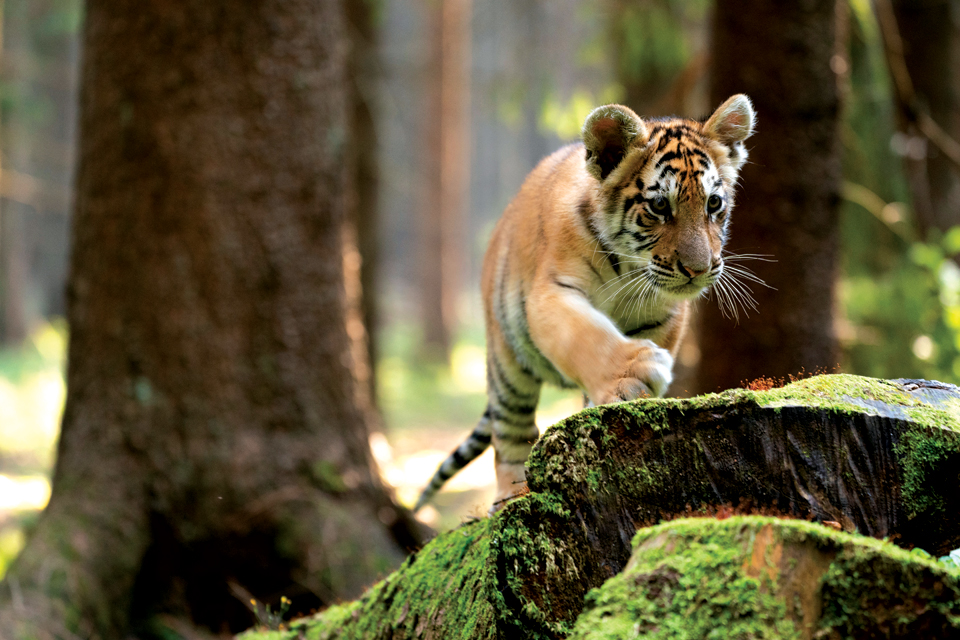
Siberian Tigers are critically endangered according to The International Union for the Conservation of Nature (IUCN)
One reason of their dwindling population is loss of habitat due to deforestation. In addition, Siberian Tigers are poached, or illegally hunted, for their fur and for body parts that are used for traditional medicines.
Approximately 350-400 adult Siberian Tigers are left in the wild, with 95% of these individuals inhabiting the forests of the Russian Far East, where they play a critical role in both the eco-system and local culture.
The Siberian Tiger is also known as an Amur Tiger. Their life span in the wild is between 15-20 years, and up to 26 years in captivity.
The Siberian Tiger resides in a small region in the southeast region of Russia. They are also located in small numbers in China and North Korea. The Sikhote-Alin mountain range in Russia contains one of the richest and most unusual temperate forests of the world. In this mixed zone between taiga and subtropics, southern species such as the tiger and Himalayan bear cohabit with northern species such as the brown bear and lynx. A small population exists in China, but it depends on animals moving across the border with Russia. It’s not known whether there are still tigers in North Korea.



The forests of the Russian Far East are declining rapidly due to large-scale illegal logging, mainly to supply Chinese furniture and flooring manufacturers, many of which then export to the US and Europe. This over-harvesting of trees reduces the supply of pine nuts and acorns, which are the main food sources for the tigers’ prey. Uncontrolled forest fires and agricultural burn-offs are also reducing the tiger’s habitat.
The Siberian Tiger is the largest cat in the world. It averages about 11 ft. in length, with a tail measuring 3 ft. Adult male Siberian Tigers can weigh up to 700 lb., while females are significantly smaller, weighing up to 400 lb. They are extremely fast and can run as fast as 40 miles per hour.
Siberian Tigers are distinguishable by their striped fur, which is unique to each tiger. Siberian Tigers differ from other tigers because they have fewer, paler stripes, and they also have manes. The mane, in addition to their thick fur, helps keep them warm.
Siberian Tigers are solitary animals, marking their scent on trees to keep other tigers away. They roam many miles and hunt often. They stalk their prey, which include elk, boar, bears, and deer, until they are close enough to pounce. When successful, they drag their kill to a secluded area before devouring the meat. These tigers also hunt smaller animals like rabbits, pikas, and fish.
The gestation period for Siberian Tigers is 3-3.5 months. Female tigers give birth once every two years at any point during the year. A litter consists of two to six cubs. The mother tiger will care for the cubs by herself, only leaving the babies alone while she hunts. Often, she cannot catch enough food for the cubs, and some will die. At 3 months, the babies will be able to leave the den; they may even go on hunts with their mother. At 18 months old, they are able to hunt on their own, but will not leave their mother’s den. When they reach 2-3 years old, they will leave the den and begin life on their own.
Many countries, including the United States, have created laws that outlaw the importation and selling of tiger parts. There are also breeding programs to help sustain the tiger population. Some people believe that zoos have a vital role to play in ensuring survival of the Siberian Tiger. It is estimated there are 500 Siberian Tigers in captivity. However, The International Union for the Conservation of Nature (IUCN) does not list captive breeding as one of the recommended conservation actions for improving the tiger conservation status. Instead, the most effective actions include protecting tiger habitats; eradicating poaching and the illegal trade of tigers and their parts; engaging with indigenous and local communities; and increasing the effectiveness of tiger and habitat management.
An adult Siberian male tiger’s home range has been documented to reach 772 square miles, while a resident female tiger rearing cubs requires up to 174 square miles in the wild. By comparison, the entire Six Flags Wild Safari Park in Jackson Township, New Jersey is just 0.55 square miles — and only a portion of this land is dedicated to the Tigris Asiana section, which is further divided between other animals including Bengal Tigers, Nilgai, Yak, and Aoudad. Six Flags recently announced the birth of five Siberian Tiger cubs. Now, these precious cubs will have to endure the gawking stares and frantic pointing of spectators for their entire lives in a theme park, far removed from the natural environment they evolved to inhabit.
Six Flags is not the only entity at fault here; the news outlets describing this tiger birth as a win for tiger conservation are empowering this devastatingly futile cycle, which perhaps decreases the resources needed for real conservation efforts. By reporting on the birth of these cubs as a conservation win, media outlets distort the issue, giving the public the false impression that captivity is useful – even needed – for wildlife conservation when, in truth, captivity serves only to entertain people, not conserve species. The bottom line is captive tiger births are not a conservation win. It is critical to keep wildlife in the wild.

